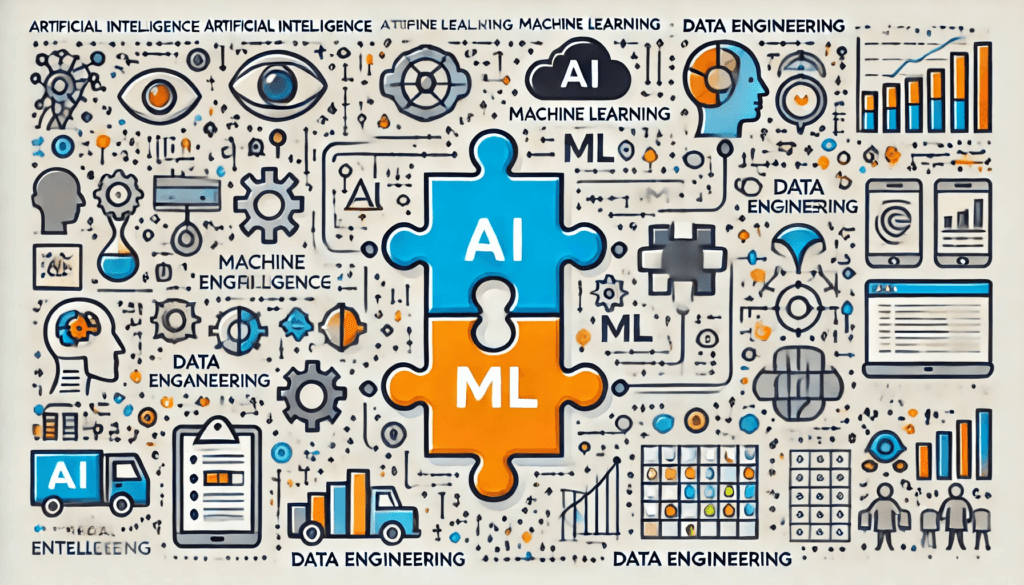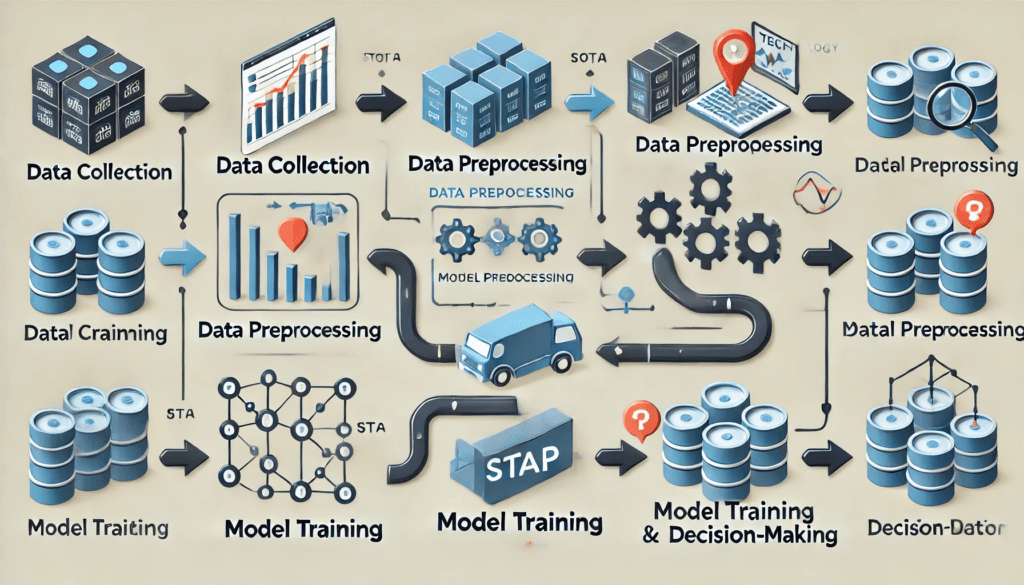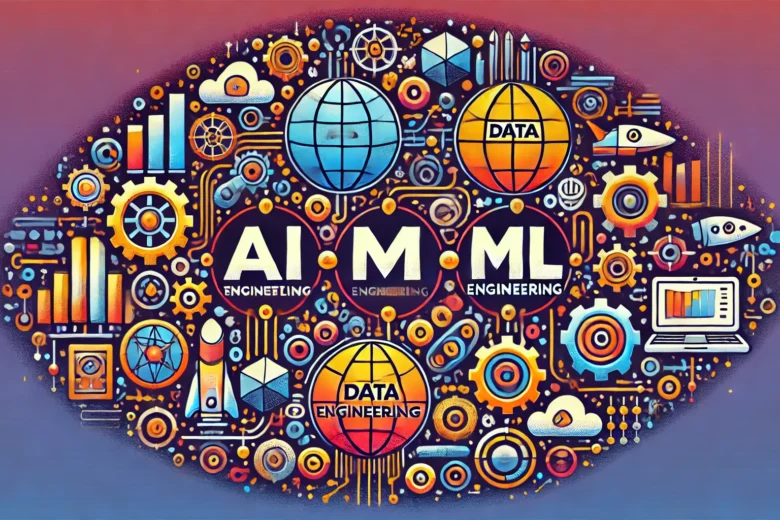TL;DR
AI, ML, and Data Engineering are transformative technologies that are reshaping industries and our daily lives. Artificial Intelligence (AI) makes machines think like humans, Machine Learning (ML) teaches computers to learn from data, and Data Engineering ensures data is organized for AI and ML models. This guide explains what these technologies are, why they’re important, how they work, when to use them, and how you can start exploring them. These skills are essential for future opportunities in a tech-driven world.
Introduction
Artificial Intelligence (AI), Machine Learning (ML), and Data Engineering have become some of the hottest topics in the tech world today. But what exactly do these terms mean, and how can they impact our everyday lives? For many people, these ideas may sound complicated, but in reality, they can be simplified for anyone to understand. In this guide, we will explore what AI, ML, and Data Engineering are, why they are important, when to use them, and, most importantly, how to start exploring these exciting fields.
Whether you want to be inspired by how technology is shaping the future or you’re simply curious, this journey will offer you a deeper understanding and practical ways to begin.
AI and ML are already playing a crucial role in transforming industries such as healthcare, finance, education, and even entertainment. From recommendation systems on your favorite streaming service to virtual assistants that help you organize your day, the impact of these technologies is immense. Data Engineering, on the other hand, ensures that all the information needed for these intelligent systems is organized, processed, and ready for use.
AI is also transforming robotics and automation, allowing machines to handle more complex tasks and making our lives easier in the process. From self-driving cars to robots that can assist in surgery, AI is pushing the boundaries of what we thought was possible. Machine learning, through techniques like deep learning, has empowered computers to perform highly sophisticated tasks such as image recognition and natural language processing.
By the end of this guide, you will not only understand the fundamentals but also be equipped to take your first steps into this amazing world of technology.
What Is AI, ML, and Data Engineering?
Artificial Intelligence (AI) is all about making machines that can think and act like humans. Imagine a computer that can understand your voice commands or recommend a movie you will love. That’s AI in action. It’s about building systems that can make decisions, solve problems, and perform tasks without being explicitly told what to do.
AI can be broken down into several categories, including Narrow AI and General AI. Narrow AI is what we see most often today—technologies designed to perform a specific task, like facial recognition or voice assistants. General AI, which is still in the realm of science fiction, aims to create machines that can understand and perform any intellectual task a human can do.
AI has also moved beyond just processing text and numbers. Today, multimodal AI is capable of understanding images, sounds, and even human emotions. For example, modern AI models like GPT-4o can process and generate content in multiple formats, which opens up even more possibilities for how we use these technologies in the real world.
Machine Learning (ML) is a subset of AI. It’s how computers learn from experience, just like humans do. Instead of being programmed with specific instructions, ML allows computers to figure things out for themselves. Think of ML as teaching a computer to recognize a cat by showing it many pictures of cats. Eventually, it gets smart enough to point out a cat on its own.
There are several types of ML, such as supervised learning, unsupervised learning, and reinforcement learning. Supervised learning involves training a model with labeled data, such as teaching a computer to recognize spam emails based on examples. Unsupervised learning deals with finding patterns in data without any labels, like grouping similar customers based on their purchasing behavior. Reinforcement learning involves learning through trial and error, often used in gaming and robotics.
Reinforcement learning is also the foundation of AI agents—systems that can autonomously learn how to perform tasks through interaction with their environment. Imagine an AI that learns how to solve a puzzle by experimenting and improving each time. This technology is being used in areas like robotics, where the machine learns to move and react to obstacles in real time.
Data Engineering is what makes AI and ML possible. It involves the preparation, collection, and transformation of data so that AI and ML algorithms can do their magic. Data engineers build the pipelines that carry all that information to where it needs to go. Without well-structured data, even the most advanced AI models cannot function effectively.
Data Engineering also involves working with different tools and technologies to store, manage, and process data efficiently. This includes databases, data warehouses, and data lakes. The work of data engineers lays the foundation for data scientists and AI experts to build their models and derive insights from data.

Why Are AI, ML, and Data Engineering Important?
Changing Lives and Industries
AI, ML, and Data Engineering are changing the world. From personal assistants like Siri and Alexa to predicting diseases, these technologies are used to solve problems more effectively than ever before. AI is even being used to fight climate change by analyzing large amounts of environmental data. In healthcare, AI can help doctors diagnose diseases more accurately and even predict health issues before they become severe.
AI is also playing a crucial role in financial services, helping detect fraudulent activities and automate trading decisions. In retail, it is used to predict customer preferences and optimize stock levels. Even in areas like transportation, AI has made huge strides—autonomous vehicles rely on AI algorithms to understand their surroundings and navigate safely.
Solving Complex Problems
ML helps solve complex issues that traditional programming cannot. For example, predicting what someone wants to watch next on a streaming service requires analyzing billions of interactions—something humans could never do as quickly. Machine learning models can recognize hidden patterns and correlations in data, providing insights that help businesses make better decisions. In finance, ML is used to detect fraud, analyze risks, and make more informed investment decisions.
In manufacturing, ML helps optimize processes, predict machine breakdowns, and improve overall efficiency. Predictive models can identify patterns of equipment wear and tear and recommend maintenance schedules that prevent costly downtimes.
Building Connections
Data Engineering makes it possible to gather insights from vast amounts of data, connecting everything from social networks to scientific research. With the right infrastructure, companies can analyze trends that help them innovate and grow. Data engineers ensure that data is available, reliable, and ready for use by data scientists and analysts. Without data engineering, AI and ML projects would be impossible to implement effectively.
For example, companies like Amazon use data engineering to keep track of millions of products, customer preferences, and transactions, allowing them to provide a seamless shopping experience. Data engineering helps bridge the gap between raw data and actionable insights, making it a vital component of the modern digital economy.
Data engineering also plays a crucial role in streamlining healthcare operations. By gathering patient data from various sources and organizing it effectively, healthcare providers can improve patient outcomes and ensure that medical staff have access to the information they need to make informed decisions.
How Does It All Work?
To understand how these fields work, let’s break down the main parts:
- Data Collection: This is where Data Engineering comes in. Data is collected from various sources—think of social media posts, transaction records, and sensor data. This information needs to be organized properly before it can be used. Data engineers gather data from different systems, clean it to remove errors, and store it in databases or data lakes where it can be easily accessed.
Data collection can also involve retrieval-augmented generation (RAG), a method that combines data retrieval with machine learning to enhance how AI models operate. RAG helps AI systems retrieve information from a large dataset, making their outputs more relevant and accurate.
- Training Models: Once the data is ready, Machine Learning comes into play. Data scientists use the information to train ML models, helping computers learn from past data. For instance, training a model to recognize different plants would involve feeding it many pictures of different species. The more data the model is trained on, the better it becomes at recognizing patterns.
Training involves feeding the machine learning model with a lot of data and adjusting the model to improve its accuracy. This process is known as model tuning, and it can be computationally intensive, requiring powerful hardware and cloud resources. Once trained, these models can be used to make predictions, classify data, or perform other tasks automatically.
Training models is becoming increasingly efficient with the use of small language models (SLMs). Unlike large language models, SLMs can be run on smaller devices, making them perfect for edge computing applications. These models are optimized to perform specific tasks with high efficiency, even when computational resources are limited.
- Decision Making: Finally, Artificial Intelligence uses these models to make decisions. Once the ML model is trained, AI systems can use it to make predictions or decisions in real time, such as a self-driving car deciding whether to stop or keep moving. These decisions are based on the patterns and information the model has learned during training.
AI systems can also adapt and learn over time. For instance, recommendation systems like those used by Netflix continuously learn from user behavior to provide more personalized suggestions. This is known as continuous learning, where models are regularly updated with new data to improve their performance.
AI is also becoming more capable with AI agents—autonomous systems that can carry out multiple tasks without human intervention. For example, AI-powered virtual assistants can schedule meetings, send emails, and manage to-do lists autonomously, making them valuable tools for increasing productivity.

When Should We Use AI, ML, and Data Engineering?
1. When Tasks Are Repetitive or Time-Consuming
AI is excellent at handling repetitive tasks. Whether it’s sorting emails, automating customer responses, or analyzing big data, AI can save us a lot of time. For example, customer service chatbots use AI to handle simple queries, freeing up human agents to deal with more complex issues.
AI can also be used for automated data entry, reducing human errors and increasing efficiency. In manufacturing, robots powered by AI can work tirelessly on assembly lines, performing repetitive tasks with precision and consistency.
2. When We Need to Make Predictions
Machine Learning is useful when we need to predict outcomes. For example, financial institutions use ML to predict if a customer might default on a loan. This ability to make data-driven predictions helps in making better business decisions. In healthcare, ML models can predict patient outcomes, such as the likelihood of readmission, allowing doctors to take preventive measures.
ML is also used in predictive maintenance. By analyzing data from sensors on machinery, ML models can predict when equipment is likely to fail, allowing companies to perform maintenance before a breakdown occurs. This helps reduce downtime and save costs.
3. When Working with Big Data
Data Engineering is necessary whenever we are dealing with huge amounts of data. Companies like Netflix and Amazon use data engineering to process millions of user actions daily, enabling them to deliver personalized content. Without the right data infrastructure, handling such large volumes of information would be impossible.
Big data is used in market analysis, customer segmentation, and product recommendations. Data engineers ensure that data is clean, organized, and accessible, allowing businesses to derive insights that drive growth and innovation. In the energy sector, data engineering is used to analyze data from smart meters and optimize energy distribution.
Data engineering also helps in retrieval-augmented generation (RAG), a technique that ensures that AI models have up-to-date and accurate information, enhancing their capabilities in a corporate environment.
Why Should You Learn AI, ML, and Data Engineering?
A Skill for the Future
AI, ML, and Data Engineering are not just buzzwords. They are essential skills for the future. As industries increasingly depend on data, understanding these technologies can open doors to exciting career opportunities. Learning about them helps you stay ahead of the curve and prepares you for the jobs of tomorrow.
The demand for professionals with AI, ML, and Data Engineering skills is growing rapidly. Fields like autonomous vehicles, healthcare, finance, and entertainment are all adopting these technologies. By learning these skills, you can become a valuable asset to any organization looking to innovate and grow.
Empowering Yourself
Learning these technologies allows you to solve problems more creatively. Imagine creating a program that helps identify health risks early or building an app that predicts weather changes to help farmers. By understanding AI, ML, and Data Engineering, you can turn your ideas into reality and make a positive impact on the world.
These skills also allow you to automate everyday tasks. For example, you could create a personal assistant that reminds you of important dates or helps you organize your day more efficiently. The possibilities are endless, and the power to innovate is in your hands.
AI and ML also allow you to create AI agents—tools that can perform multiple tasks autonomously. Imagine having an AI assistant that could book appointments, send reminders, and even provide you with personalized news updates. These agents are becoming more powerful, thanks to the development of LLMOps (Large Language Model Operations), which helps manage and optimize the deployment of large AI systems.
How Can You Start?
1. Start with the Basics
To start with AI and ML, it’s essential to learn basic programming. Python is one of the most popular languages in this field due to its ease of use and many available libraries. Websites like Codecademy and Coursera have beginner-friendly courses to help you start your journey.
In addition to Python, it’s helpful to learn about basic statistics and linear algebra, as these are the building blocks of many ML algorithms. Understanding concepts like probability, mean, median, and standard deviation will give you a solid foundation for learning machine learning.
2. Experiment with Small Projects
Hands-on experience is key. Begin by experimenting with small projects like building a chatbot or predicting house prices using ML. Websites such as Kaggle provide datasets and challenges to help you practice. These small projects will help you apply what you’ve learned and build confidence in your skills.
You can also try building a sentiment analysis tool that determines whether a product review is positive or negative. This will help you understand natural language processing (NLP), a crucial aspect of AI. The more you practice, the more comfortable you will become with these technologies.
3. Learn About Data Engineering
To understand Data Engineering, you should get familiar with databases and tools like SQL. Platforms like Udacity offer courses that teach how to work with data pipelines and manage data effectively. Understanding how to design and build data systems is crucial for making data available and usable for AI and ML models.
It’s also helpful to learn about cloud platforms like AWS, Azure, or Google Cloud. These platforms offer services that make it easier to work with big data and deploy machine learning models at scale. Learning how to use cloud services will give you an edge in the job market.
4. Get Involved in a Community
Joining online forums such as Reddit or Stack Overflow is an excellent way to learn from others. The community is full of people willing to help, share insights, and guide you when you’re stuck. Participating in online discussions can also help you stay updated with the latest trends and technologies.
You can also attend meetups and conferences to connect with like-minded individuals. Networking with others in the field can lead to mentorship opportunities, collaborations, and even job offers. Being part of a community makes the learning process more enjoyable and rewarding.
5. Explore Advanced Topics
As you become more comfortable with the basics, you can start exploring advanced topics like deep learning, reinforcement learning, and LLMOps. Learning how to optimize and manage AI models in production is an essential skill, especially as AI systems become larger and more complex. Platforms like DeepLearning.AI offer courses on advanced AI topics to help you take your knowledge to the next level.
Conclusion
AI, ML, and Data Engineering are transformative technologies that have redefined how we solve problems, make decisions, and innovate across industries. They enable us to handle massive amounts of data, automate tasks, and make accurate predictions—all of which were impossible with traditional methods. By understanding these technologies, you open doors to new opportunities and gain the power to create solutions that can impact the world in meaningful ways.
Whether you are a student, a professional, or someone curious about technology, now is the perfect time to explore AI, ML, and Data Engineering. Start small, experiment, and build your knowledge step by step. The skills you acquire today can help you stay ahead in the rapidly evolving landscape of technology and play a part in shaping the future.
Embrace the journey of learning, and don’t hesitate to take that first step. The world of AI is vast and full of potential—there’s no limit to what you can achieve!

